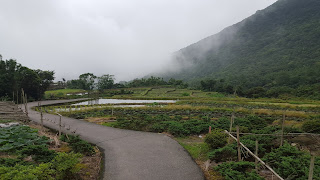Taipei's North Gate's Much Needed Makeover
Right before the Chinese New Year Taipei City started demolishing a long ramp up to the Zhongxiao Bridge which, while helpful for drivers, was a massive eye sore in one of the city's most heavily visited central areas. Now, several weeks on, the construction is nearing its end, commuters have gotten used to new traffic flows, and a small park has been built around what was previously an overlooked landmark. Despite living here for a long time, there is something cool about actually being able to pass through the gate and hang out in the space around it without being in the middle of traffic.
The outward side of the gate, as seen from the new park.
The new park under development, with the Zhongxiao bridge in the back.
The city side of the gate seen from Boai Road.
The move was one of many designed by city hall to make Taipei a more pedestrian friendly place and encourage residents and visitors to get around on their own power. Many visitors to Taipei at some point will pass between Taipei main station and Ximen, making the newly redesigned gate area one of a few must-see stops on a walk through the area. In addition, some renovations have been ongoing at a Japanese structure across the way which hopefully will become something engaging for visitors. Another big winner in the makeover to the area is the city's central post office, first completed around 1930, which again looks the part with its large columns and Japanese art deco style.
A near-forgotten colonial-era building across the street.
The North Gate is one of four gates which remain in the city which mark the spots where people would pass through the old city wall that was built under the Qing dynasty. What is remarkable about the north gate is that it is the only one which kept its original design and has survived from the 19th century. It is truly what the old city gates would have looked like.
I wouldn't fly to Taiwan just to see it, but if you're nearby the few extra minutes of walking it would take a visitor to see the gate are worth it, if only for a few photos. If you're really moved by the history you can take a look at some of the recently unearthed artifacts and displays in the nearby Beimen MRT station.
Ximen's gate, which was the west gate, was destroyed under Japanese colonial rule as part of an urban redesign project. The three other gates visitors can see today were rebuilt from ruins in the 1940s and were modified to fit the Nationalist style of architecture. Two of them are found on Aiguo road, and the third is planted squarely at the foot of Ketagalan Boulevard at Zhongshan Road. Of the three, the Ketagalan Boulevard one is the only gate which cannot safely be seen up close on foot, although none of them are equipped like the newly redesigned north gate.
Just east of Chaing Kai Shek memorial hall. Nationalist era design, is moderately pedestrian friendly.
Near Zhonghua intersection. My candidate for the next pedestrian update.
Hopefully, at some point in the future one or both of the gates along Aiguo road can be improved to allow more visitation. The gate near Zhonghua road is most suited to get improvements since the streets which pass around it are smallest and it sits in the middle of a parkway. It's also on the shortest biking and walking path between the history museum, postal museum, and the botanical gardens on Nanhai road and the Ximen and Longshan temple parts of town. For a city that's fighting so hard to build on its heritage, there is little reason not to hope to see more improvements in the future.








Comments
Post a Comment